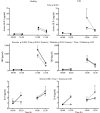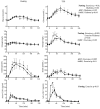Glycemic and Metabolic Effects of Two Long Bouts of Moderate-Intensity Exercise in Men with Normal Glucose Tolerance or Type 2 Diabetes
- PMID: 28744255
- PMCID: PMC5504214
- DOI: 10.3389/fendo.2017.00154
Glycemic and Metabolic Effects of Two Long Bouts of Moderate-Intensity Exercise in Men with Normal Glucose Tolerance or Type 2 Diabetes
Abstract
Background: The glycemic and insulinemic responses following 30-60 min of exercise have been extensively studied, and a dose-response has been proposed between exercise duration, or volume, and improvements in glucose tolerance or insulin sensitivity. However, few studies have examined the effects of longer bouts of exercise in type 2 diabetes (T2D). Longer bouts may have a greater potential to affect glucagon, interleukin-6 (IL-6) and incretin hormones [i.e., glucagon-like peptide-1 (GLP-1) and glucose-dependent insulinotropic peptide (GIP)].
Aim: To examine the effect of two bouts of long-duration, moderate-intensity exercise on incretins, glucagon, and IL-6 responses before and after exercise, as well as in response to an oral glucose tolerance test (OGTT) conducted the following day.
Methods: Twelve men, six with and six without T2D, participated in two separate conditions (i.e., exercise vs. rest) according to a randomized crossover design. On day 1, participants either rested or performed two 90 min bouts of treadmill exercise (separated by 3.5 h) at 80% of their ventilatory threshold. All participants received standardized meals on day 1. On day 2 of each condition, glucose and hormonal responses were measured during a 4-h OGTT.
Results: On day 1, exercise increased IL-6 at the end of the first bout of exercise (exercise by time interaction p = 0.03) and GIP overall (main effect of exercise p = 0.004). Glucose was reduced to a greater extent in T2D following exercise (exercise by T2D interaction p = 0.03). On day 2, GIP and active GLP-1 were increased in the fasting state (p = 0.05 and p = 0.03, respectively), while plasma insulin and glucagon concentrations were reduced during the OGTT (p = 0.01 and p = 0.02, respectively) in the exercise compared to the rest condition for both healthy controls and T2D. Postprandial glucose was elevated in T2D compared to healthy control (p < 0.05) but was not affected by exercise.
Conclusion: Long-duration, moderate-intensity aerobic exercise can increase IL-6. On the day following exercise, fasting incretins remained increased but postprandial insulin and glucagon were decreased without affecting postprandial glucose. This long duration of exercise may not be appropriate for some people, and further research should investigate why next day glucose tolerance was unchanged.
Keywords: aerobic exercise; glucagon; glucagon-like peptide-1; glucose tolerance; glucose-dependent insulinotropic peptide; insulin.
Figures

 = exercise,
= exercise,  = rest (Control),
= rest (Control),  = standardized meal,
= standardized meal,  = blood samples,
= blood samples,  = heart rate variability and indirect calorimetry.
= heart rate variability and indirect calorimetry.

References
LinkOut - more resources
Full Text Sources
Other Literature Sources

